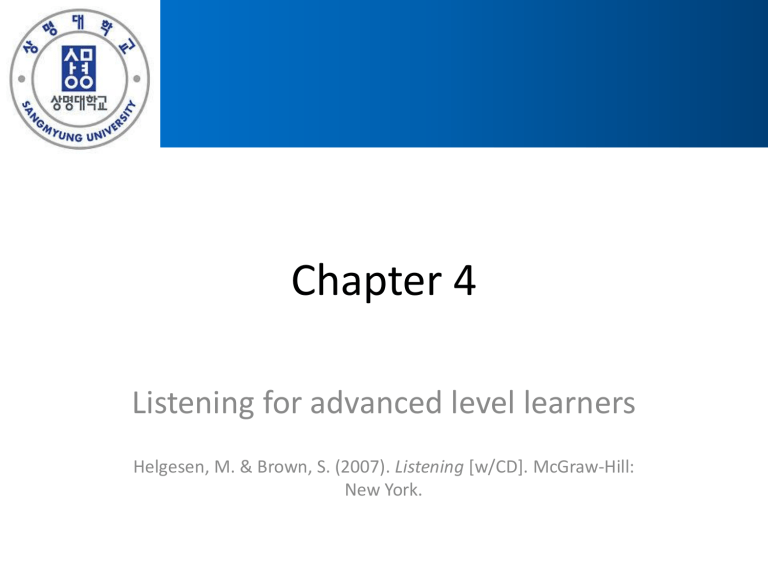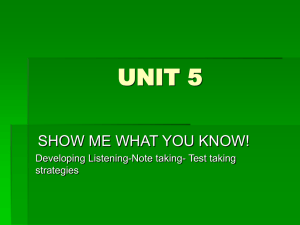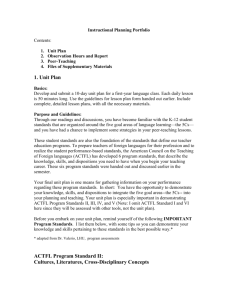Chapter 4 - Daniel Craig

Chapter 4
Listening for advanced level learners
Helgesen, M. & Brown, S. (2007). Listening [w/CD]. McGraw-Hill:
New York.
ACTFL Proficiency Guidelines
• Summaries of all ACTFL Proficiency Guidelines
• This book discusses listening for novice, intermediate, and advanced proficiency language learners.
• This chapter focuses on advanced learners.
Advanced Listening Abilities
• Able to understand:
– Main ideas and most details
– Speech about a variety of topics, including those beyond the immediate situation.
– Interviews, short lectures if the topic is familiar, and factual reports such as the news.
Discourse Issues
• At this level, learners need to improve listening to longer texts
• This is often ESP (English for specific purposes)
– EAP (English for academic purposes)
– Job/career listening skills
• Also
– Interpersonal skills
– Disorganized or non-linear listening
Cultural Issues
• Connotations are the hidden meanings behind language.
– There is a need to go beyond dictionary definitions.
• Cultural literacy is the ability understand culturally embedded language, norms, expectations, and so forth.
• Issues of L1 interference in listening, speaking, and (non-)verbal feedback (back channeling).
Authentic Texts
• The use of “authentic” materials is a significant focus in CLT
– Genuine text authenticity
• Created for real-life purpose. Not intended as a teaching aid. Not altered for the classroom
– Altered text authenticity
• No change in meaning (or language). Extracts or shorter segments are presented for easier consumption.
– Adapted text authenticity
• Meaning is the same, but the original has been edited for use in a classroom
(vocabulary/grammar). The information is authentic, but the form is not.
– Elaborated text
– Simulated text authenticity
• Text was created specifically for the classroom, but it was created as if it were for an authentic use
– Inauthentic texts
• Created with little concern for the appearance of authenticity
Authentic Tasks
• Target tasks (real world) vs. Pedagogical tasks
(classroom)
– Genuine task authenticity
• Tasks done in ways and for reasons they would be in the real world.
– Simulated task authenticity
• Task that reflects a real world task, but modifies it for classroom practice and assessment.
– Pedagogical task authenticity
• No attempt is made to make the task resemble a real world task.
Build on what learners already know about listening
• Build on what learners already know about listening.
– Techniques used with lower-level learners can be paired with more difficult texts.
• Increased difficulty of tasks
– More sophisticated learning strategies (pp. 65-68)
• Metacognitive strategies
– Strategies that cause us to evaluate our own learning processes.
• Self-regulation, Meta-memory, & Meta-comprehension
• Questioning, reflecting, journaling, planning, etc…
Teach the culture as well as the language
• Provide cultural information that is not always included in activities with authentic materials.
• As a teacher, you need to take the time to learn this cultural information as well to better serve your learners.
• Draw connections between your students’ background and the background shared by participants in the text
Help learners understand the structure of longer texts
• Help learners understand common formats of different genres: lectures, stories, news reports, etc…
• Micro-skills (pp. 109-110) (mostly for lectures, but true for many genres)
– Identify:
• What the lecture is about
• How topic changes over time
• Main ideas and their connections
• Relationship between different parts (cause/effect, main argument, conclusion)
• Discourse markers (connecting words/phrases)
• Picking out important information and topic changes from language and voice.
• Vocabulary
• Understanding words from context
• Speaker’s attitude (language, tone, etc.)
– Recognize
• Difference between relevant and irrelevant topics
• Body language used to indicate important ideas, changes in topic, etc.
Tasks and Materials
• Condensing
– Collecting and organizing information.
• Extending
– Providing opinions, predictions, rationales, and so forth that go beyond the text.
• Modeling
– Listening as an example of how learners can interact, such as role plays.
• Conversing
• Songs, movies, TV, & stories
Assessment
• Focus on norm-referenced tests (TOEFL, TOEIC, IELTS, etc.)
– TOEIC
• Listen to question, choose best response
• Main ideas and details based on short conversation
• Short talk or announcement and answer questions about main ideas, details, and purpose of speaker.
– Responsive listening – listen and choose from several answers.
– Information transfer questions – Choose picture or other response based on short text.
• Classroom assessment for beginner/intermediate works as well.
• Portfolio
– Selective collection of learner’s work with reflections on their performance.
• Listening activities from both inside and outside of class.
• Formal assessments as well as informal activities.
– Digital portfolios provide many options for use with multimedia.
Hints
• Great general listening hints (origin pp. 120-
121)
– Don’t try to listen to all the words and sentences.
– Don’t stop listening when facing unknown words.
– Don’t focus on sentence structures.
– Don’t try to translate the dialogues into your first language.









